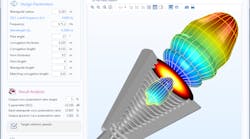The latest version of Comsol’s Multiphysics simulation software contains special upgrades for modeling radio frequency parts. It is not only faster at loading and saving files, but it also features a library of standard RF parts that can be easily modified and shared.
The library in Comsol's RF Module aims to take more responsibility for modeling things like thermal effects in microwave filters, signal paths in wireless antennas, and interference in transmission lines. Measuring these effects requires little more than editing the geometry, material properties, and solver setting of the library's parts.
“The benefit of using the parts library is that you don’t have to create the work from scratch, which saves you a lot of time and subsequent resources,” Jiyoun Munn, RF technical product manager at Comsol, said in an email. The parts are “parameterized, which allows you to make any edits to the parts themselves so that they match what you are analyzing.”
The library, introduced last week in Comsol Version 5.3, might not attract anyone who doesn't already own Multiphysics. But it provides a welcome relief to the heavy lifting required in previous versions of the RF Module. Before Version 5.3, the software came with an application library, but engineers had to modify the parts manually.
A spokeswoman for Comsol said in an email that the library not only saves time in building models but also makes “RF simulations more accessible by providing new users with predefined parts to pick from.” The broader Version 5.3 updates also include tools for automating repetitive operations.
Other changes introduced last week promise to cut down on wasted time. Comsol says the software is ten times faster when loading and saving files as well as doing virtual geometry operations. It is also easier now to share models and simulations, so that engineering teams can test designs for different applications.
